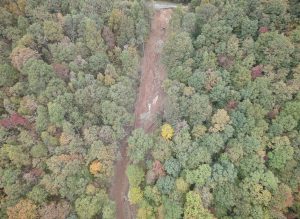OPINION: Do better about rule following on trails
March 7, 2023
With an entrance to the Blue Ridge Parkway just minutes away, tourists and High Country residents are no strangers to sights such as the outstanding Linville Falls and views on the Profile Trail of Grandfather Mountain. To protect such magnificent sights, the Blue Ridge Parkway has established a set of rules to facilitate tourism that protects both visitors and nature alike.
Before someone hits the dusty trail, they should consider looking at rules and regulations posted by the park they may be visiting. Many parks have specific rules in place to keep the environment pristine and safe, while also providing the visitor with safety tips. The Blue Ridge Parkway has a website dedicated to many Parkway travel tips, ranging from how to be safe around animals to accessibility and accommodations in the national park. The website especially emphasizes the importance of staying on trail. When visitors go off a trail, there may be a lasting environmental impact, or their safety may be in danger. When rules are not followed while hiking, it endangers the longevity of the environment surrounding the trail, endangers animals and habitats around the parks, and makes visitors susceptible to potential danger as well.
There are 369 miles of trails on the Blue Ridge Parkway that can be explored, so choosing to go off these trails and disrupt natural ecosystems is destructive and pointless. There are many protected species of plants on the Blue Ridge Parkway, so there are rules and regulations about poaching these plants. Bears are a prominent animal on the parkway, and while they may generally be docile creatures, if they are not expecting human interaction, they may be less docile. The U.S. National Park Service expects visitors to remain at least half of a football field away from all animals seen while visitors explore the parks. A bear attack is a great way to ruin a fun trip.
More creatures to be cautious of on the Blue Ridge Parkway are two venomous snakes, the timber rattlesnake and the northern copperhead. These two species of venomous snakes appear in North Carolina. It is much harder to see these snakes off trail, as there is less of a clear cut path. If a hiker were to get bitten by one of these venomous snakes and they are off trail, it is unlikely that they will reach safety in time.
The National Park Service has produced the Seven Principles of Leave No Trace, which was created in an attempt to continue the protection of the national park system. The first principle states the importance of planning ahead and being prepared. This principle is important to consider, as it is very likely that one could encounter danger if they are not following the rules posted by the NPS.
Next, the NPS emphasizes the importance of camping on durable surfaces. If a visitor of a national park decides to camp on a surface that is not intended to support the weight of the tent, the camper’s tent could be ruined or the plants below the tent may be ruined. The NPS lists campgrounds that are already created and ready to use, so choosing to camp elsewhere is disrespectful and disruptive.
The NPS also covers the importance of appropriately using a fire pit. There are specific rules that must be followed if one wishes to have a fire during their stay. It is important to use only dry and dead wood found on the ground. Also, campsites in the parks often have fire rings for visitors to use.
The following two principles signify the importance of leaving what one finds and disposing of waste properly. Leaving waste on trails and campsites greatly harms the environment of the trail as it is unsanitary and animals may eat this waste and be unable to digest the foods properly.
Guests may be tempted to pick flowers or other foliage they come across on the trails. This is against the Leave No Trace principles, as plants are harmed by people picking them or walking over them. The last two principles of Leave No Trace demonstrate the importance of leaving wildlife and other travelers alone during their retreat in the mountains. If a visitor is being disruptive by going off trail or being inconsiderate of other travelers, the experience of the visit can be ruined. When animals are not left alone, park guests may be harmed. Leave No Trace encourages hikers to appreciate the parks they are visiting in a safe way by staying on trail and following other safety rules and regulations that are posted by individual parks. It is important for hikers to follow these rules to keep the high country beautiful for all visitors.












